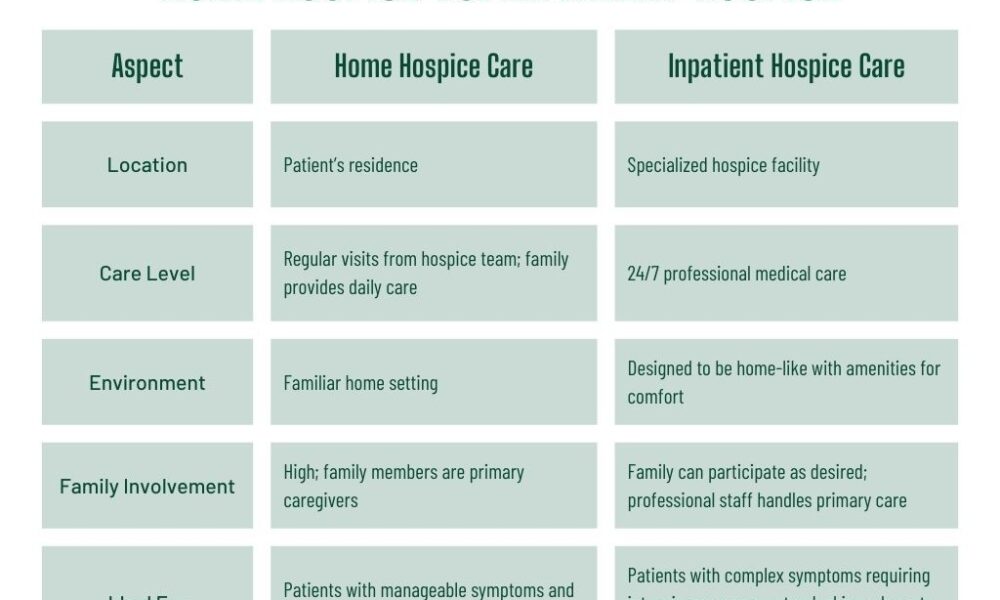Hospice Services at Home vs Facility: What’s Best?

One of the most profound decisions for patients and families when faced with a terminal illness is where to receive end-of-life care. Hospice services offer a compassionate approach focused on quality of life, rather than cure, for individuals with a prognosis of six months or less to live. But one pressing question often arises: Should hospice care be received at home or in a facility?
Both settings offer unique advantages and challenges. The right choice depends on a variety of personal, medical, and logistical factors. In this blog, we explore the nuances of each option to help guide you through this deeply personal decision.
Understanding Hospice Services
Hospice services provide interdisciplinary, holistic care to individuals who are in the final stages of a terminal illness. The goal is not to prolong life but to ensure that a person’s final days are lived with dignity, comfort, and as little pain as possible.
These services typically include:
- Medical care and pain management
- Emotional and spiritual support
- Social work and counseling
- Assistance with activities of daily living (ADLs)
- Bereavement support for families
Whether at home or in a facility, the mission remains the same: to enhance quality of life and ease suffering.
Hospice Services at Home: Comfort in Familiar Surroundings
Pros of In-Home Hospice Care
- Comfort and Familiarity
Many people feel most at ease in their own homes, surrounded by familiar faces, routines, and personal belongings. In-home hospice care allows patients to spend their final days in an environment where they feel emotionally safe and connected. - Personalized Family Involvement
Families often play a more active role in caregiving at home. This increased involvement can be emotionally fulfilling, giving loved ones a sense of purpose and connection during a difficult time. - Flexibility and Control
Home-based care offers greater flexibility in daily routines, meals, and visitation. Patients and families have more autonomy over how care is delivered and how they spend their time together. - Cost-Effective Option
In many cases, hospice services at home are more cost-effective than facility care, particularly when insurance or Medicare covers services and equipment.
Challenges of In-Home Hospice Care
- Caregiver Burden
While emotionally meaningful, caregiving can be physically and mentally exhausting. Not all families have the capacity, skills, or time to provide consistent, high-level care. - Limited Medical Equipment
Home settings may not accommodate all the medical equipment or modifications needed for complex conditions. This can limit the type of interventions available. - Emergency Readiness
In case of sudden complications or symptom flare-ups, home care may require prompt support from hospice teams, which might not be immediately available 24/7 in rural areas. - Home Environment Limitations
Small or cluttered homes, stairs, or a lack of appropriate bathroom facilities can complicate care delivery and patient comfort.
Hospice Services in a Facility: Professional Support in a Clinical Setting
Facilities offering hospice services include specialized inpatient hospice centers, nursing homes, and hospitals with hospice wings. These environments are equipped to handle intensive care needs while still emphasizing comfort and emotional support.
Pros of Facility-Based Hospice Care
- Comprehensive Medical Support
Facilities are staffed 24/7 by trained medical professionals. Immediate clinical support may benefit patients with complex symptoms or those requiring advanced pain management. - Relief for Caregivers
Families often experience relief knowing their loved one is in professional hands. This frees them from the physical demands of caregiving and allows them to focus more on emotional connection. - Accessibility of Equipment and Services
Facilities are equipped with everything from hospital beds and oxygen to advanced monitoring systems and therapy rooms—things that might not be feasible to set up at home. - Structured Environment
A structured routine can provide predictability and reassurance, particularly for patients with cognitive impairments such as dementia.
Challenges of Facility-Based Hospice Care
- Less Personalized Environment
Despite best efforts, facilities can feel sterile or impersonal. Patients may miss the comfort of their home and pets, or the ability to dictate their daily rhythm. - Restricted Visitation and Schedules
Facilities often have rules about visiting hours and the number of visitors. This can interfere with the natural flow of family interactions and moments of closeness. - Emotional Distance
Professional care, while excellent, may not carry the same warmth and personal touch as family-provided care at home. Some patients may feel more isolated or anxious in a clinical environment. - Cost Considerations
Depending on insurance and facility type, out-of-pocket costs for room, board, and certain medical services may be higher than those for home care.
Choosing the Right Setting: Key Factors to Consider
Every individual and family has unique needs and preferences. When deciding between hospice services at home or in a facility, consider the following:
- Patient Wishes
If the patient is able to express preferences, their comfort and desires should be prioritized. Some people long to die at home, while others feel safer in a medical environment.
- Level of Medical Need
Patients requiring constant monitoring, frequent medication adjustments, or specialized equipment may be better served in a facility.
- Family Capacity
Consider whether family members can physically and emotionally provide care, and whether their living situation can support medical equipment and hospice visits.
- Financial Considerations
Review insurance coverage, Medicare or Medicaid options, and out-of-pocket costs for both home and facility care.
- Location and Availability
In some regions, specialized hospice facilities may be limited. Likewise, rural homes may have longer response times from hospice teams.
A Hybrid Option: Transitional Hospice Services
Some patients begin hospice care at home but transition to a facility later, as needs evolve. Others may enter a hospice facility temporarily for symptom management, then return home.
This flexible approach allows families to adapt to changing circumstances and ensures continuity of care throughout the journey.
There’s No One-Size-Fits-All
The decision between hospice services at home and in a facility is profoundly personal. What’s “best” is not defined by medical protocols alone, but by love, comfort, support, and the unique needs of each patient and family.
Whether in a cozy bedroom or a dedicated hospice suite, the true essence of hospice care remains the same: providing compassion, dignity, and peace at the end of life.
If you’re navigating this decision, consider consulting with a hospice provider. They can assess your situation, offer guidance, and tailor a care plan that aligns with your loved one’s values and needs.




